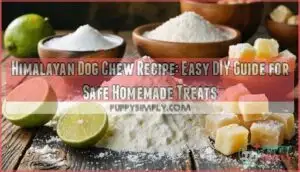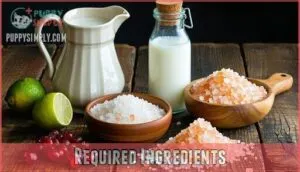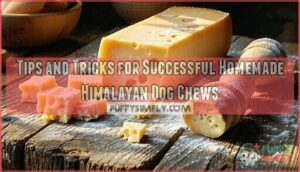This site is supported by our readers. We may earn a commission, at no cost to you, if you purchase through links.

Heat one gallon of skim milk, add lime juice to curdle it, then strain the curds and press out excess whey.
Mix in a pinch of salt, shape into chew-sized pieces, and let them air-dry for 7-10 days until rock-hard.
Your dog gets the same long-lasting treat they’d buy from the store, but you control every ingredient, which is a worth it payoff when you see your pup’s excitement over these custom-made chews.
Table Of Contents
- Key Takeaways
- Benefits of Homemade Himalayan Dog Chews
- What Are Himalayan Dog Chews and Why Are They Safe?
- How to Make Homemade Himalayan Dog Chews
- How to Customize Himalayan Dog Chews for Your Dog
- Tips and Tricks for Successful Homemade Himalayan Dog Chews
- How Long Do Homemade Himalayan Dog Chews Last?
- Can People Enjoy Himalayan Yak Cheese for Dogs?
- Additional Dog Treat Recipes to Explore
- Frequently Asked Questions (FAQs)
- How to make a himalayan dog chew?
- What are the ingredients in Himalayan chews for dogs?
- What do vets think of yak chews?
- How often can I give my dog a Himalayan chew?
- What temperature should milk reach when boiling?
- How much vinegar per cup of milk?
- Can frozen milk be used for chews?
- What if curds dont form properly?
- Are moldy chews safe to give dogs?
- Conclusion
Key Takeaways
- You’ll need just three simple ingredients – skim milk, lime juice, and salt – to make homemade Himalayan dog chews that give you complete control over what goes into your dog’s mouth.
- The process involves boiling milk, adding acid to create curds, straining, pressing for 4-6 hours, then air-drying for 7-10 days until the chews become rock-hard and long-lasting.
- You can customize hardness, size, and ingredients based on your dog’s breed, age, and chewing habits – use skim milk for harder chews or whole milk for softer ones.
- Proper storage in airtight containers keeps these chews fresh for months, and you’ll save money compared to store-bought versions while ensuring your dog gets a safe, digestible treat.
Benefits of Homemade Himalayan Dog Chews
Making your own Himalayan dog chews gives you complete control over what goes into your dog’s mouth, from the hardness level to the exact ingredients used.
You’ll know exactly what your pup is chewing on, avoiding the mystery chemicals and questionable sourcing that often comes with store-bought alternatives, which provides peace of mind.
Control Over Hardness, Size, and Ingredients
When you make homemade Himalayan dog chews, you’re the chef calling the shots on every detail that matters.
Texture Customization becomes your superpower—squeeze those curds harder for aggressive chewers who need rock-solid Hardness Levels, or go gentle for senior pups with tender teeth.
Size Variation means cutting perfect portions whether you’ve got a tiny Chihuahua or a Great Dane.
Ingredient Safety stays in your hands with natural ingredients like skim milk, vinegar, and Himalayan salt—no mystery chemicals here.
Your DIY dog treats can accommodate Dietary Needs by adjusting milk fat content or adding beneficial extras like kelp.
This homemade dog treat approach lets you control dog chew hardness and dog chew ingredients precisely, creating the perfect match for your furry friend’s unique needs.
Ethical Sourcing and Eco-Friendly Packaging
Beyond controlling your Himalayan dog chew’s texture and ingredients, you can make environmentally conscious choices that benefit both your pet and the planet.
Sustainable ingredients and ethical sourcing practices create a ripple effect of positive impact.
Consider these eco-friendly approaches for your homemade yak cheese chew:
- Source organic milk from local farms practicing fair trade and proper animal welfare standards
- Choose recycled packaging materials or reusable containers for storage instead of single-use plastics
- Compost leftover whey and food scraps to reduce your carbon footprint
- Select Himalayan salt from suppliers committed to sustainable mining practices
- Use natural dog chew wrapping materials like beeswax cloth for eco-packaging solutions
Customization for Dog’s Breed and Age
When you’re crafting these chews, remember that one size doesn’t fit all—your Great Dane’s needs differ vastly from your Chihuahua’s requirements.
Puppy chew size should be smaller and softer to protect developing teeth, while senior dog texture needs to accommodate weaker jaws and potential dental issues.
Consider breed-specific ingredients based on your dog’s sensitivities; allergy considerations become essential when selecting milk types or additives.
Age customization means adjusting hardness through milk fat content—skim milk creates tougher chews for aggressive chewers, while whole milk produces gentler options.
Monitor your dog’s chewing habits to determine ideal puppy chew toy dimensions and senior dog treats consistency for their unique needs.
Use of Skim Milk for Best Results
While you can customize these chews for any dog’s needs, using skim milk for your Himalayan dog chew recipe delivers superior results.
The skim milk benefits include faster drying time and better hardness control, creating chews that last longer than those made with whole milk.
The reduced fat content allows for proper milk curdling during the cheese making process, resulting in firmer curds that compress more effectively, making your dog treat recipe produces chews with excellent breed suitability.
This means your dog treat recipe produces chews that are sturdy enough for aggressive chewers yet customizable for smaller breeds.
The lower fat content also improves chew longevity, giving you more bang for your buck while ensuring your pup gets a safe, nutritious treat.
Be cautious about introducing other dairy products, as lactose intolerance is common among dogs.
What Are Himalayan Dog Chews and Why Are They Safe?
If you’ve ever wondered about those incredibly tough, long-lasting chews your dog goes crazy for, you’re looking at Himalayan dog chews – traditional yak cheese treats that originated in the mountains of Nepal and Tibet.
These natural chews pack serious nutritional punch while being completely safe and digestible, unlike sketchy rawhide alternatives that can cause choking or blockages, making them a great choice for dog owners concerned about their pet’s health and digestible safety.
Definition and Origin of Himalayan Dog Chews
Himalayan dog chews trace their roots back thousands of years to the high-altitude communities of Nepal, Bhutan, and Tibet, where resourceful herders developed chhurpi as a way to preserve precious yak and cow milk.
This traditional preparation method involves boiling milk, adding lime juice and salt, then pressing and air-drying the cheese blocks for weeks until they achieve rock-hard durability.
Here’s what makes these chews special:
- Cultural Significance – Originally created by Tibetan monks and local villagers as human sustenance during harsh winters
- Regional Variations – Different areas use yak, cow, or goat milk, creating unique flavors and textures
- Chew Composition – The ancient fermentation process removes most lactose while concentrating protein and nutrients
Today’s himalayan cheese treats maintain this yak cheese history, supporting traditional communities while providing your dog with a safe, digestible alternative to synthetic chews that honors centuries of Himalayan craftsmanship.
These chews are also known for their benefits to dental health, helping to remove plaque as your dog enjoys them.
Nutritional Benefits and Digestibility
These nutrient-packed treats deliver impressive health benefits that’ll make your dog’s tail wag with joy.
Protein content ranges from 59-69.6% per 100g, supporting muscle development and repair in active pups.
Calcium benefits shine through with 1,200-1,500mg per 100g, strengthening bones and teeth naturally.
Unlike traditional rawhide, these himalayan dog chews are fully digestible dog chews that pass through your pet’s system in 12-24 hours.
Lactose levels remain minimal due to the fermentation process, making these yak cheese chews suitable for sensitive stomachs.
Digestibility factors include natural ingredients without artificial additives, while added nutrients like phosphorus and magnesium support overall wellness.
These healthy dog treats double as effective dog dental treats, scraping away plaque while providing long-lasting chewing satisfaction.
Regular chewing also helps to scrape away tartar.
Gluten-Free and Lactose-Free Options
Good news for pet parents worried about food sensitivities – authentic himalayan dog chew recipes are naturally glutenfree and lactosefree.
The traditional curing process removes lactose during production, making these treats safe for dogs with digestibility concerns. You won’t find gluten, grains, soy, or corn in genuine recipes, which reduces allergy considerations substantially.
When making homemade yak cheese chew treats, you can use lactose removal techniques or start with lactose-free milk for milk substitutions. The lactose removal happens naturally as whey separates from curds, leaving behind a protein-rich snack that’s easier on sensitive stomachs.
For dog allergies related to grains, these chews offer perfect gluten alternatives since they’re made with just milk, salt, and citrus juice – no wheat or grain fillers needed. Some dogs experience symptoms of intolerance, like itching and digestive issues.
Dental Hygiene and Chewing Instinct Satisfaction
Your dog’s teeth work overtime, and a Himalayan dog chew becomes their personal dental assistant.
These protein-packed treats tackle the double duty of satisfying your pup’s natural urge to gnaw while scrubbing away troublesome buildup.
Here’s how these chews boost your dog’s oral health:
- Plaque Reduction – The firm texture acts like a natural toothbrush, scraping away sticky film
- Tartar Control – Regular chewing prevents hardened deposits from forming on teeth
- Breath Improvement – Cleaner teeth mean fresher doggy kisses for everyone
- Instinct Fulfillment – Satisfies that primal need to chew without destroying your furniture
- Gum Stimulation – Promotes healthy blood flow and strengthens jaw muscles
The mechanical action of chewing creates friction that naturally removes plaque while keeping your dog happily occupied.
Supervision for Aggressive Chewers
While these chews promote excellent dental health, you’ll need to watch your dog carefully if they’re an aggressive chewer.
Aggressive chewers need extra supervision to prevent choking hazards and injuries.
Different chewing styles require different approaches – some dogs gnaw slowly while others attack treats like they’re solving a puzzle.
Choose appropriate chew sizes based on your dog’s mouth to prevent choking hazards in dog treats.
Replace worn-down pieces immediately for injury prevention, and always supervise puppies during chew time.
Aggressive chewer solutions include shorter supervised sessions and selecting harder chews that won’t break into dangerous fragments for injury prevention.
How to Make Homemade Himalayan Dog Chews
Making homemade Himalayan dog chews is surprisingly simple and requires just three basic ingredients you likely have in your kitchen.
This traditional recipe gives you complete control over the texture, size, and quality of your dog’s chews while saving money compared to store-bought versions.
Required Ingredients
Making homemade Himalayan dog chews requires just three core ingredients.
Milk Selection starts with skim milk for the hardest chews, though yak milk offers traditional authenticity.
Curdling Agents like lime juice or white vinegar separate curds from whey effectively.
Salt Types include Himalayan sea salt for preservation and flavor.
Flavor Additives such as cranberries for dogs boost nutrition.
Ingredient Sourcing matters—choose quality ingredients for safety and taste.
These treats are similar to traditional Himalayan chews.
Step-by-Step Instructions
Now that you’ve gathered your ingredients, it’s time to transform them into delicious homemade dog treats your pup will adore.
Begin by heating your milk to a rolling boil over medium-high heat, stirring constantly to prevent scorching. Add lime juice and salt, then stir continuously for 1-2 minutes using proper curdling techniques.
Let the mixture rest for 5-15 minutes until curds form completely. Strain through cheesecloth, squeezing out excess whey.
Press under heavy weight for 4-6 hours—this pressing duration determines your chew’s final hardness.
Slice into appropriate pieces using safe slicing methods, then bake at 150°F drying temperatures for 40 minutes. Allow proper cooling time before serving this DIY recipe to your four-legged friend.
Using a Dehydrator for Faster Drying
A dehydrator revolutionizes your himalayan dog chew production by cutting drying time from days to hours.
Set the dehydrator temperature to 150°F and expect 12-18 hours for complete drying, depending on your desired chew hardness.
Different dehydrator models offer varying energy consumption rates, but most efficiently handle multiple batches.
You can even find a dog chew dehydrator online for purchase.
This dog treat drying method produces consistently textured chews while you sleep, and it’s essential to monitor progress periodically—thicker pieces need longer dehydrating time for that perfect firm bite your pup craves.
Storage and Shelf-Life Considerations
Your homemade chew’s longevity depends on proper storage techniques and moisture control. Store finished treats in airtight containers away from direct sunlight and heat sources—think cool, dry places like pantries or cabinets.
Proper dog treat storage prevents spoilage and maintains texture for weeks or months. Monitor for spoilage signs like mold, off odors, or excessive softness before offering treats.
Avoid refrigeration impact since condensation increases moisture levels, reducing shelf life. Longevity factors include initial drying thoroughness and storage conditions.
Well-dried chews stored correctly can last several months, while improperly stored ones may spoil within days.
How to Customize Himalayan Dog Chews for Your Dog
Every dog has unique needs, and customizing your homemade Himalayan chews guarantees they’re perfect for your furry friend’s specific requirements.
You can adjust everything from hardness and size to ingredients, making these treats work for puppies, seniors, and dogs with special dietary needs.
Softening Chews for Dogs With Dental Issues
Dogs with broken teeth or dental issues deserve gentle chewing options that won’t worsen their condition.
You can transform your homemade Himalayan chews into softer alternatives through several effective methods:
- Soaking Techniques – Submerge chews in warm water for 15-30 minutes before serving
- Microwaving Method – Heat softened chews for 10-15 seconds to achieve ideal chew texture
- Steaming Options – Steam chews for 5 minutes to maintain nutritional value while softening
- Broth Infusion – Soak in low-sodium chicken broth for added flavor and moisture
These Safe Alternatives help maintain your dog’s oral care routine without causing pain. Regular dental care helps prevent periodontal gum disease.
When making chews specifically for dogs with dental health concerns, use full-cream milk instead of skim milk during preparation—this creates naturally softer treats from the start. Monitor your pup’s comfort level and adjust softening methods accordingly.
Adjusting Serving Size Based on Dog’s Size
Getting the portion size right for your furry friend isn’t rocket science, but it does require some common sense.
You’ll want to match your Himalayan dog chew to your pup’s breed size and chewing habits for maximum safety and enjoyment.
Here’s a practical sizing guide to help you nail the perfect portion every time:
| Dog Size | Chew Dimensions | Chew Duration | Weight Management | Special Notes |
|---|---|---|---|---|
| Small breeds (under 25 lbs) | 1-2 inches long | 30-60 minutes | Monitor closely | Puppy portions work well |
| Medium breeds (25-60 lbs) | 2-3 inches long | 1-2 hours | Standard serving | Adjust for activity level |
| Large breeds (60-90 lbs) | 3-4 inches long | 2-3 hours | Larger portions OK | Consider splitting into sessions |
| Giant breeds (over 90 lbs) | 4+ inches long | 3+ hours | Multiple pieces daily | Senior dogs may need softer versions |
| Puppies/Senior dogs | Varies by mouth size | Supervised sessions | Smaller, frequent treats | Prioritize safety over duration |
Remember, even the most enthusiastic chewer needs properly sized treats to avoid choking hazards.
Monitoring for Allergies and Intolerances
Watching your dog’s reaction to new chews helps you catch allergies early before they become serious health problems.
You’ll want to introduce homemade Himalayan chews gradually and monitor for Allergy Symptoms like itching, digestive upset, or ear infections that signal pet treat allergies.
Here’s your monitoring checklist:
- Watch for excessive paw licking, scratching, or skin irritation after Gradual Introduction of new chews
- Track digestive changes like vomiting or diarrhea that might indicate dog treat intolerances
- Document any unusual behaviors during dog treat monitoring sessions
If symptoms appear, stop the chews immediately and consider Veterinary Consultation for proper diagnosis and Alternative Chews recommendations.
Exploring Ingredient Variations and Additions
While ingredient variations offer exciting possibilities for customizing your homemade chews, you’ll want to start with proven additions that enhance both nutrition and appeal.
Milk alternatives like goat or sheep milk create unique flavors, while kelp for dogs provides essential minerals as a natural nutritional boost.
Dried cranberries (chopped small) add antioxidants and mild sweetness, and turmeric delivers anti-inflammatory benefits with a golden color.
For texture modifications, try varying milk fat content or adding small amounts of coconut oil.
Always consider allergen considerations when introducing new dog treat additions – test small amounts first to confirm your pup tolerates these flavor enhancements well.
Tips and Tricks for Successful Homemade Himalayan Dog Chews
Making perfect homemade Himalayan dog chews becomes much easier when you know the right techniques and can troubleshoot common problems.
You’ll discover professional tips that guarantee consistent results every time, plus creative variations to keep your furry friend excited about their healthy treats.
Following Rodney Habib’s Tutorial
Following Rodney Habib’s tutorial gives you a foolproof roadmap for perfect Himalayan dog chew recipe results.
His approach emphasizes Habibs Milk Choice using skim milk for ideal texture, while his curdling agent comparison shows lemon juice works best.
You’ll master pressing time impact through his 4-6 hour recommendation, and understand drying method differences between oven and dehydrator techniques.
Rodney’s chew hardness control methods let you customize treats for your dog’s needs, and his step-by-step process eliminates guesswork, making homemade dog chews accessible for beginners.
Follow his DIY dog chews wisdom, and you’ll create professional-quality dog treat recipe results every time.
Common Issues and Troubleshooting
Several issues can derail your homemade chew project, but they’re easily fixable with the right approach.
Cracking Prevention starts with proper moisture control during drying—too fast equals splits. Chew Splintering often results from over-drying, while Texture Problems stem from incorrect milk fat content or pressing time.
Mold Growth signals inadequate dog treat drying methods, so guarantee complete dehydration.
Dog Rejection usually means the dog chew texture is wrong for your pup’s preferences, requiring dog treat moisture control adjustments and following dog treat safety precautions from trusted dog treat recipe notes.
Future Experimentation and Recipe Variations
Once you’ve mastered the basic recipe, countless flavor infusions and texture modifications await your creativity.
You can transform ordinary chews into gourmet treats your dog will crave. Alternative milks like goat or buffalo create unique textures, while added supplements such as turmeric boost nutritional value.
Here are three exciting dog treat recipe variations to try:
- Antioxidant boost – Mix spirulina or turmeric into curds for vibrant colors and health benefits
- Veggie blend – Incorporate pureed sweet potato or pumpkin for extra vitamins and natural sweetness
- Novel shapes – Use cookie cutters or molds to create fun forms that match your dog’s personality
Pet treat experimentation opens endless possibilities for ingredient variations. Dog treat flavor experimentation lets you discover what makes your pup’s tail wag most enthusiastically. These pet treat unique combinations guarantee every batch becomes a tail-wagging success story.
How Long Do Homemade Himalayan Dog Chews Last?
Once you’ve crafted your homemade Himalayan dog chews, proper storage determines whether they’ll last weeks or years.
The key factor is moisture content—completely dried chews stored in airtight containers can remain fresh for months, while slightly moist ones need refrigeration and won’t last as long.
Proper Storage in Airtight Containers
Smart storage starts with choosing the right airtight container for your homemade Himalayan dog chews. You’ll want containers that block moisture and air completely—think glass jars or food-grade plastic containers with tight-sealing lids.
Store them in cool, dry places away from direct sunlight to prevent spoilage. You can find various treat containers online.
| Storage Factor | Best Practice |
|---|---|
| Container Type | Glass jars or BPA-free plastic with secure lids |
| Temperature | Room temperature (65-75°F) or refrigerated |
| Location | Cool, dark pantry or cupboard |
| Humidity Control | Dry environment, avoid moisture exposure |
Proper dog treat storage extends your chew’s shelf life substantially when moisture stays controlled.
Shelf-Life Based on Moisture Content
Your homemade Himalayan chews’ dog treat shelf life hinges on moisture content—get this right, and you’ll have treats that last months instead of molding within days.
Moisture Impact directly affects both safety and longevity, with properly dried chews containing less than 14% moisture staying fresh substantially longer than softer versions.
Drying Methods and Storage Practices work together to maximize your treats’ lifespan:
- Low moisture content (below 14%) creates shelf-stable chews lasting several months to years
- Airtight containers prevent humidity exposure that softens chews and encourages spoilage
- Cool, dry storage locations maintain suitable pet treat moisture content levels
- Proper dehydration using ovens or dehydrators removes excess water activity
- Regular monitoring for Spoilage Signs like soft spots, mold, or unusual odors guarantees safety
Longevity Factors include your drying thoroughness and storage environment—pet treat shelf life depends on keeping moisture out after processing.
Can People Enjoy Himalayan Yak Cheese for Dogs?
You can safely eat the homemade Himalayan dog chews you make for your pet, since they’re basically a hard cheese made from simple ingredients like milk, lime juice, and salt.
These protein-rich treats offer the same nutritional benefits for humans as they do for dogs, making them a healthy snack you can both enjoy together.
Nutritional Benefits and Taste for Humans
While exploring this recipe, you’ll discover that yak cheese offers impressive nutritional benefits for human consumption too.
The cheese flavor is mild and slightly tangy, making it surprisingly enjoyable as a snack.
When comparing nutrients, yak cheese provides high protein content, essential calcium, and beneficial omega-3 fatty acids.
For recipe adaptation, you can create human-friendly versions by reducing salt content and adding herbs.
However, safety concerns exist regarding proper preparation and storage.
Understanding dog nutrition information helps you appreciate why this treat works well for pets.
The pet nutrition profile shows excellent digestibility compared to commercial alternatives.
Both dog treat nutritional value and taste make this recipe worthwhile for sharing with your furry friend.
Sharing Safe and Healthy Snacks With Your Dog
Creating these himalayan dog chew treats lets you share Safe Snack Sharing moments with your furry friend.
You’ll control ingredients, avoid harmful Dog Food Additives, and practice proper Treat Portion Control.
Reading Dog Food Labels becomes unnecessary when you make homemade treats.
Watch for signs of Recognizing Food Allergies during initial tastings.
This dog treat recipe promotes excellent dog chew safety while supporting pet nutrition and overall dog health through natural ingredients.
Additional Dog Treat Recipes to Explore
Once you’ve mastered making Himalayan dog chews, you’ll want to explore other homemade treats that’ll keep your pup’s tail wagging.
From sweet potato jerky to frozen yogurt bites, there’s a whole world of healthy, budget-friendly options waiting in your kitchen.
Expanding Your Homemade Treat Options
Beyond traditional Himalayan dog chew recipes, you can expand your homemade treat arsenal with creative variations that’ll keep your pup’s tail wagging.
Consider these exciting alternatives:
- Alternative Proteins: Experiment with goat, sheep, or buffalo milk for unique flavors and textures
- Grain-Free Options: Add spirulina or turmeric for natural health benefits without fillers
- Frozen Dog Treats: Transform your cheese mixture into summer-friendly frozen variations
These natural dog treats work perfectly in treat puzzle toys, and you can incorporate seasonal ingredients to create year-round variety.
You can also make treats with wholesome rolled oats for a nutritious snack.
Trying Out Different Ingredients and Flavors
Your dog’s taste buds deserve variety! Experiment with milk alternatives like goat or sheep milk for unique flavor enhancements. Add nutritional boosts through dried cranberries or kelp powder.
Try turmeric for anti-inflammatory benefits or spirulina for extra vitamins. Create texture variations by adjusting milk fat content—whole milk makes softer chews, skim milk creates harder ones.
Consider allergen considerations when introducing new dog treat ingredients. Start small with ingredient variations and monitor your pup’s reactions.
Dog treat flavor experimentation keeps tails wagging while dog treat additions provide health benefits. Remember, dog treat ingredient substitutions should always prioritize safety over novelty.
Frequently Asked Questions (FAQs)
How to make a himalayan dog chew?
You’ll need skim milk, vinegar, and salt. Boil the milk, add vinegar to create curds, strain through cheesecloth, press for hours, then slice and dry until hard.
What are the ingredients in Himalayan chews for dogs?
You’ll need just three simple ingredients: milk (skim, whole, or low-fat), citrus juice (lemon or lime), and Himalayan salt. Some recipes add turmeric or spirulina for extra nutrition.
What do vets think of yak chews?
Veterinarians remain divided on yak chews: most vets don’t recommend them, as they could result in a painful fractured tooth, while others support their dental health benefits.
You’ll want supervision for safer chewing.
How often can I give my dog a Himalayan chew?
You can give your dog a Himalayan chew 2-3 times per week, depending on their size and chewing habits. Always supervise aggressive chewers to prevent choking hazards.
What temperature should milk reach when boiling?
Like watching a pot that never boils, you’ll wait for your milk to reach a rolling boil at around 212°F.
Heat it on medium-low, stirring constantly to prevent scorching the bottom, which is a complete concept in preventing milk from burning.
How much vinegar per cup of milk?
You’ll need about 1-2 tablespoons of vinegar per cup of milk to properly curdle it. Start with one tablespoon, then add more if needed until curds form nicely.
Can frozen milk be used for chews?
Why pour money down the drain when frozen milk works perfectly?
You’ll need to thaw it completely first, then proceed with your usual recipe.
The freezing process won’t affect the curdling or final chew quality.
What if curds dont form properly?
If curds don’t form properly, you likely need hotter milk or more acid.
Try adding another tablespoon of vinegar or lemon juice, then gently stir and wait a few minutes for separation.
Are moldy chews safe to give dogs?
No, moldy chews aren’t safe for dogs.
Mold can produce toxins that’ll make your pup sick, causing vomiting, diarrhea, or worse health issues.
Toss any moldy chews immediately and stick to fresh ones.
Conclusion
Like a master craftsman turning raw materials into treasured tools, you’ve transformed simple milk into lasting joy for your furry companion.
This himalayan dog chew recipe puts quality control in your hands, ensuring every bite meets your standards.
Your dog gets premium treats while you enjoy the satisfaction of creating something special together.
With proper storage, these chews provide weeks of entertainment. Remember to supervise chewing sessions and adjust sizes for your pup’s needs.
Happy treat-making!
- https://bloomingculture.com/blogs/news/how-to-make-himalayan-dog-chews-blooming-culture-pet
- https://www.reddit.com/r/puppy101/comments/nbvjz3/homemade_hemalayan_chews_yak_cheese_are_really/
- https://devildogpetco.com/blogs/the-devil-dog-blog/himalayan-yak-chew
- https://www.dogseechew.in/blog/himalayan-dog-treats-a-healthy-and-nutritious-option-for-your-dog
- https://woofcrate.ca/blogs/woofpost-blog/chew-on-this-10-surprising-health-benefits-of-yak-chews



















